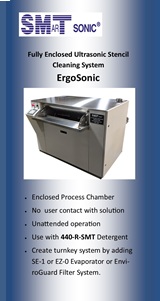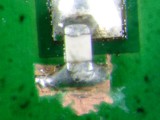|

|
|
| Ask the Experts | |||||||||||
|
|||||||||||
|
April 14, 2025 - Updated October 8, 2014 - Originally Posted Exposed Copper Risk
This PCB is used in an outside environment exposed to high humidity and temperatures extremes. Should we be concerned with corrosion? What should we do? A.H. |
|||||||||||
| Expert Panel Responses | |||||||||||
|
I would not recommend leaving exposed copper in ANY environment. There are a couple of ways to deal with this issue:
Senior Applications Engineer Flexible Circuit Technologies Mark Finstad has over 30 years in the flex circuit industry in both design and manufacturing. He is a regular speaker at IPC APEX (Professional development courses) and PCB West (flex circuit design courses). He is also vice chair of IPC-2223 and active member of IPC-6013. Finstad has extensive experience with both domestic and off-shore manufacturing.
The copper will be more susceptible to oxidization, but will likely not cause too much more of a risk for corrosion. However, coating it epoxy or masking is easy, cheap and will rule out any corrosion or other issues.
Manufacturing Engineer Esterline Interface Technologies Mr. Hughes has been in the electronics manufacturing field for 20 years. Operating the processes and as a manufacturing engineer for the last 14 years. He is also a CIT as well as an SMTA Certified Process Engineer.
I would suggest you purchase some solder mask touch up pens and simply touch in the areas of exposed Copper. This should be more than sufficient. If you cannot purchase these then a light coat on the area of conformal coating will be sufficient, but get one with a UV light trace so you can double check it is covered.
Technical Sales Manager BLT Circuit Services Ltd Greg York has over thirty two years of service in Electronics industry. York has installed over 600 Lead Free Lines in Europe with Solder and flux systems as well as Technical Support on SMT lines and trouble shooting.
The exposure copper adjacent the surface ground layer has the potential for corrosion from ionic contamination and environmental effects. Halide ions, notably chloride and bromide ions can penetrate areas of the copper surface. When the copper pad is exposed to environmental effects, tiny pits can form on the copper surface. The oxidation of the copper enables pitting and crevice corrosion. To mitigate these corrosion potentials, I recommend that the exposed copper be cleaned post soldering and then coated to prevent environmental exposure.
CTO Kyzen Corp. Mr. Bixenman is the CTO for Kyzen Corp. Kyzen Corp. is a leading provider of engineered cleaning fluids for high technology manufacturing environments.
The exposed copper is definitely a problem for outdoor environment and humidity.The copper is likely to corrode and eaten away due to corrosion. The corrosion product (salt) produced could form acid with excess moisture and lower insulation resistance, between tracks nearby. One type of correction can be applying conformal coating (Polyurethane- preferred) selectively to exposed area that can provide some protection from corrosion. Exposed copper definitely does not meet IPC-A-610E requirements.
Head-Quality Astra Microwave Products, Hyderabad, AP India Holds Degree in Engineering, started off as Scientist/Engineer in ISRO (Indian Space Research Organization) in Quality Assurance of Space hardware Electronics Production. Worked in the area of Parts, Material and Process; DPA, FA and Process Qualification for space and ground hardware. Later moved into Private sector and worked in the area of Quality Management Systems & ISO 9001 certification. Currently hold a position as Head-Quality in RF/Microwave Product manufacturing for Defense and Aerospace segment.
Absolutely. Bare copper? Ever leave a penny outside? Green in no time. Either go with conformal coating for the entire board, my suggestion, or localized conformal coating for the reworked area. You indicate that the PCB is used "in an outside environment exposed to high humidity and temperatures extremes. Should we be concerned with corrosion?" If your product is currently not protected from these harsh environmental conditions are you not already seeing failures? A PCB used in those condition should be completed encased in a quality conformal coating.
President JSK Associates Based in. Northern California since 1971. Founded JSK Associates in 1979. Actively involved in soldering, cleaning, chemistries. 30 years experience in EOS/ESD control.
Yes you should be concerned if you expect your product to be in the filed longer than 18 months, and if your product is exposed to humidity and temperatures. You would need to confirm that all off you pre manufacturing process such as wave soldering and hand soldering are RoHS compliant. Non RoHS compliant products such as fluxes, contain acids such as chlorine or bromine. This is corrosive after the soldering operation and would cause corrosion of the surface during operation of the product. Many cleaning and testing methods were developed to clean the surfaces and to test to insure the surfaces were noncorrosive afterwards. The majority of these test methods involved checking for ionic contamination after the cleaning was performed. A passing product would have a low level of ionic contamination. (I strongly recommend that you do this test, to confirm that the products used on your PCB are RoHS compliant.) RoHS compliant products, such as "no-clean" fluxes compose of organic acids such as a dipic acid or citric acids. These organic acids are decomposed by the temperatures reached during soldering, and are likely to have very slow or low corrosive effects. I recommend that you make use of a solder mask pen, which will offer a solder mask coating over your exposed copper. This is the safest, and most cost effective way to resolve your problem.
Process Engineering Manager - Electronics Altech UEC, South Africa Currently with Altech UEC and responsible for technology road map in PCBA electronic manufacturing and technical support for PCBA electronic manufacturing for Altech UEC and its JDM's. Over 7 years in SMT, Radial Insertion, Wave solder & Test Applications.
Yes!
SME - PWB Technologies Northrop Grumman Mahendra Gandhi has been working in interconnect industry since 1972.
Ina word, yes, you should be concerned. The level of risk really depends on the enclosure and operating environment. If the product will continually produce enough heat to keep it above dew point, the risk will be substantially lower.If the product does not operate continuously, however, then the risk is higher. Another issue is the levels of ionic materials in the end use environment. If, for instance, the product might be used where salt is present, e.g. near the ocean,the corrosion risk is greater. The exposed copper will always represent a greater corrosion risk than the solder, however there is a corrosion risk for both. Conformal coating can help to protect against moderate amounts of moisture. It will not protect against gross amounts of liquid, however.
Process Engineer Astronautics Fritz's career in electronics manufacturing has included diverse engineering roles including PWB fabrication, thick film print & fire, SMT and wave/selective solder process engineering, and electronics materials development and marketing. Fritz's educational background is in mechanical engineering with an emphasis on materials science. Design of Experiments (DoE) techniques have been an area of independent study. Fritz has published over a dozen papers at various industry conferences.
Yes, you do have a potential corrosion issue. You may use conformal coating to spray on the exposed copper on the populated board and change to different surface finish, such as HASL, in the future.
Director New Product Development Metallic Resources, Inc David Bao has more than fifteen years of experience in developing new solder paste, wave soldering fluxes and other SMT consumables. He currently serves as the Director of New Product Development at Metallic Resources Inc. He received a Ph.D. in Chemistry at Oklahoma State University.
Reader Comment
If the Printed Wired Boards (PWB) need to work under humid conditions esp. for high reliability applications, I would suggest to have a protective coating, to protect from various ionic contaminants as well as the exposed copper getting oxidized.
Dr. KUTTIYIL THOMAS OOMMEN THARAKAN, VSSC
The following procedure may be followed:
When soldering the end of the chip resistor to the exposed ground plane, simply flux and solder the exposed copper around the part at the same time. Then clean, dry, and touch-up the area with conformal coating. That way there is no possibility of exposed copper, coating or no coating.
Advanced Engineer/Scientist General Dynamics Richard D. Stadem is an advanced engineer/scientist for General Dynamics and is also a consulting engineer for other companies. He has 38 years of engineering experience having worked for Honeywell, ADC, Pemstar (now Benchmark), Analog Technologies, and General Dynamics.
|
|||||||||||
| Submit A Comment | |||||||||||
|
Comments are reviewed prior to posting. You must include your full name to have your comments posted. We will not post your email address. |
|
Free Newsletter Subscription
Circuitnet is built for professionals who bear the responsibility of looking ahead, imagining the future, and preparing for it. Insert Your Email Address |
|

|











